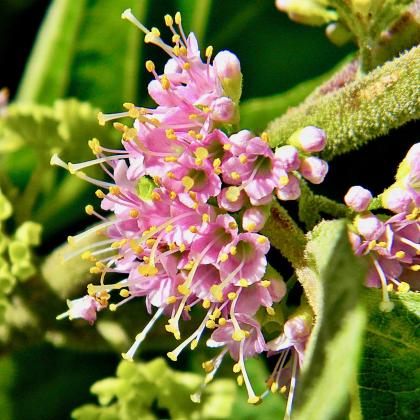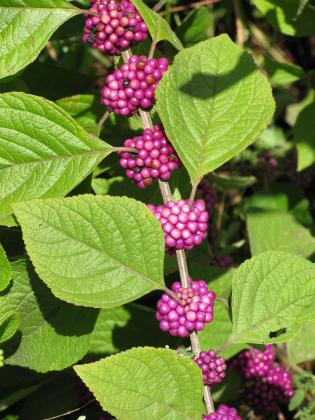Callicarpa americana – Protection for deployed US troops
Callicarpa americana, American beautyberry, is a 4 to 5 foot tall drought-tolerant deciduous shrub native to Central Texas and southern U.S. In late spring it has pale pink flowers that ripen into bright magenta to purple berries in September through October. They are actually drupes spiraling around branches in a swirl. You might see both flowers and fruit on the same plant. After the leaves have fallen, berries remain on the stem. The opposite leaves, 2½ to about 5 inches long, have saw-toothed edges. Their underside and stem may have fine hairs.
Callicarpa is from two Greek words, callos, beauty and carpos, fruit. A perennial, beautyberry is seen in landscapes as an understory plant.
It is classified as a pioneer species meaning that it is one of the first plants to grow back in an area that was previously damaged by something like a fire. It will grow in a variety of soil types and in a wide pH range.
Texas Parks and Wildlife, tpwd.texas.gov, in their article “Nature Trails of the Nature Center” say the berries are important to critters during dry months because they are 80% water. Many humans say the flavor is only so-so when eaten raw. Some people get an upset stomach if they eat a lot of raw berries. However, most say beautyberries make an excellent jelly. C. americana is in the Food and Drug Administration Poisonous Plant Database at fda.gov.
Beautyberry is being studied on medical and insecticidal fronts. The National Institutes of Health, ncbi.nlm. nih.gov, said the “genus contains pharmacologically active components, and numerous extracts have shown positive results in a range of bioassays relevant to human health.” The article is “Biologically Active Natural Products of the Genus Callicarpa”. Traditional systems including the Native American Ethnobotany Database, naeb.brit.org, list beautyberry for malarial fever, rheumatism, edema (water retention), dizziness, skin conditions such as acne vulgaris, etc.
The U.S. Department of Agriculture Agricultural Research Service, ARS, ars.usda. gov, has studied beautyberry leaves as an insect repellent. It works with universities and the Deployed War-Fighter Protection program, DW-FP. Sponsored by the Department of Defense, DOD, DWFP is a research program administered by the Armed Forces Pest Management Board, www.acq.osd.mil. With sprays, treated uniforms, etc., deployed troops are protected from mosquitoes and other insects where there is a danger of malaria or other insect-borne diseases. Research ensures that the troops have updated protection as more is learned. The article “DWFP: A Battle Plan to Protect U.S. Troops from Harmful Insects” is at agresearchmag.ars.usda. gov.
The University of Mississippi, UM, olemiss.edu, has played a major role in the discovery of callicarpenal, a beautyberry chemical. Callicarpenal studies began when a researcher said that as a child, he saw adults place beautyberry leaves under the harnesses of animals to repel insects. People rubbed them on their skin for the same reason. The use of callicarpenal as a mosquito repellent has been patented by ARS. More information is in the UM article “UM, USDA and DOD Join Forces to Protect Deployed U.S. Troops”.
Deborah Richardson is a freelance reporter for The Examiner with a fondness for flora in its natural setting.



